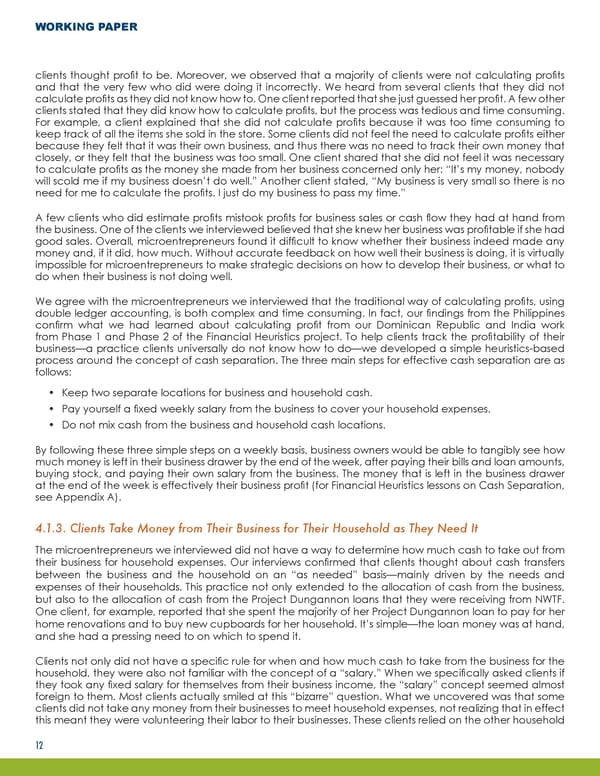WORKING PAPER clients thought profit to be. Moreover, we observed that a majority of clients were not calculating profits and that the very few who did were doing it incorrectly. We heard from several clients that they did not calculate profits as they did not know how to. One client reported that she just guessed her profit. A few other clients stated that they did know how to calculate profits, but the process was tedious and time consuming. For example, a client explained that she did not calculate profits because it was too time consuming to keep track of all the items she sold in the store. Some clients did not feel the need to calculate profits either because they felt that it was their own business, and thus there was no need to track their own money that closely, or they felt that the business was too small. One client shared that she did not feel it was necessary to calculate profits as the money she made from her business concerned only her: “It’s my money, nobody will scold me if my business doesn’t do well.” Another client stated, “My business is very small so there is no need for me to calculate the profits. I just do my business to pass my time.” A few clients who did estimate profits mistook profits for business sales or cash flow they had at hand from the business. One of the clients we interviewed believed that she knew her business was profitable if she had good sales. Overall, microentrepreneurs found it difficult to know whether their business indeed made any money and, if it did, how much. Without accurate feedback on how well their business is doing, it is virtually impossible for microentrepreneurs to make strategic decisions on how to develop their business, or what to do when their business is not doing well. We agree with the microentrepreneurs we interviewed that the traditional way of calculating profits, using double ledger accounting, is both complex and time consuming. In fact, our findings from the Philippines confirm what we had learned about calculating profit from our Dominican Republic and India work from Phase 1 and Phase 2 of the Financial Heuristics project. To help clients track the profitability of their business—a practice clients universally do not know how to do—we developed a simple heuristics-based process around the concept of cash separation. The three main steps for effective cash separation are as follows: • Keep two separate locations for business and household cash. • Pay yourself a fixed weekly salary from the business to cover your household expenses. • Do not mix cash from the business and household cash locations. By following these three simple steps on a weekly basis, business owners would be able to tangibly see how much money is left in their business drawer by the end of the week, after paying their bills and loan amounts, buying stock, and paying their own salary from the business. The money that is left in the business drawer at the end of the week is effectively their business profit (for Financial Heuristics lessons on Cash Separation, see Appendix A). 4.1.3. Clients Take Money from Their Business for Their Household as They Need It The microentrepreneurs we interviewed did not have a way to determine how much cash to take out from their business for household expenses. Our interviews confirmed that clients thought about cash transfers between the business and the household on an “as needed” basis—mainly driven by the needs and expenses of their households. This practice not only extended to the allocation of cash from the business, but also to the allocation of cash from the Project Dungannon loans that they were receiving from NWTF. One client, for example, reported that she spent the majority of her Project Dungannon loan to pay for her home renovations and to buy new cupboards for her household. It’s simple—the loan money was at hand, and she had a pressing need to on which to spend it. Clients not only did not have a specific rule for when and how much cash to take from the business for the When household, they were also not familiar with the concept of a “salary.” we specifically asked clients if they took any fixed salary for themselves from their business income, the “salary” concept seemed almost foreign to them. Most clients actually smiled at this “bizarre” question. What we uncovered was that some clients did not take any money from their businesses to meet household expenses, not realizing that in effect this meant they were volunteering their labor to their businesses. These clients relied on the other household 12
 Using Behavioral Science to Design a Customer-Centric Financial Management Training for Microentrepreneurs Page 14 Page 16
Using Behavioral Science to Design a Customer-Centric Financial Management Training for Microentrepreneurs Page 14 Page 16